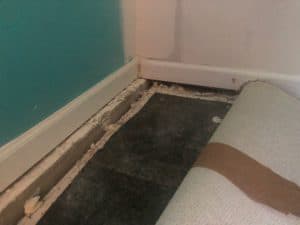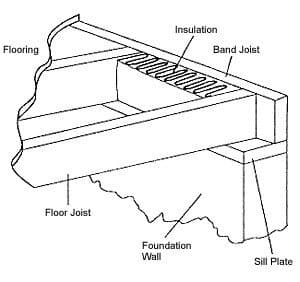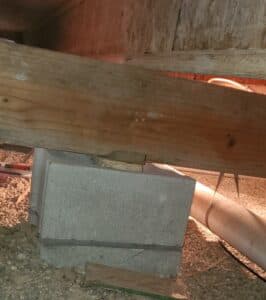How much does it cost to fix sagging floors? A full pricing breakdown.

Originally posted 12/26/19, updated 9/20/23
When your floors start sloping or sagging, you know there’s something wrong with the structure of your home. There are several possible causes for these problems, depending on how your home was built.
Founded in 1996, Acculevel has repaired structural wood flooring systems and foundations for more than 30,000 customers’ homes.
We want you to benefit from our 27+ years of experience and know how to budget for sagging floors repairs. Most contractors have a job minimum for wood repairs; Acculevel’s minimum is $800. In the last 12 months, our customers paid an average of $6200 to fix their uneven floors. This number can be misleading because there are a wide range of variables that can affect costs.
In this article, we will break down the repair methods and costs associated with all of the types of sagging floors. Our intention is to help you make an informed decision about what you need to repair your home.
The first and most significant factor is the construction material of your floor. This is because concrete slab floors don’t have the wooden structural elements that come with a basement or crawl space.
FYI: All floor repair costs in this article include material and labor costs.
How Much Does It Cost to Fix Sagging Concrete Slab Floors?
If you don’t have a basement or crawl space, you have a slab foundation. And when the soil under your foundation shifts or erodes, that slab will sink.
In most cases, concrete lifting is the best and most reliable repair method. At Acculevel, we believe slab jacking is the best type of concrete lifting. It fills any voids under the slab with a lightweight polyurethane that foams up to raise the floor. The costs for slab jacking begins at $2000 and will increase depending on how much material is needed and how large the area is to complete the repair. Curious how our slab jacking method compares to mud jacking? This article walks you through both options.

This photo was taken by an Acculevel project advisor during a free home assessment. The slab foundation has sunk, creating a gap between the floor and the baseboard.
However, if the soil below your slab is compromised and too soft for several feet, slab jacking is going to be a temporary and insufficient repair. This is because the soft soil will continue to settle, causing more foundation problems and making your floors sink again.
In those instances, the best way to repair your sinking foundation is via helical piers. This is because piers are drilled down until they reach undisturbed soil — more than 20 feet below your home. The price of piers ranges from $1750-$2700 per pier, depending on placement, depth, load requirements, and if they are installed by machine or by hand.
For detailed information about helical piers, you can read our companion article about pier use and costs. In some cases, both methods are needed to fix uneven floors.
The Cost to Fix Sagging Floors in Basements and Crawl Spaces
This may be stating the obvious, but all of the structural wood framing in your home is interconnected. This means that the problem may not be limited to your home’s sill plate or rotted wood beam. In our experience, we find that multiple parts of the flooring system are usually affected. The direction or type of sagging floor usually highlights the area of greatest concern, which is how we explore the types of repairs below.
There are multiple causes that account for your sagging floor, but you should know that water and humidity often play a role. When you are planning to make repairs to your wooden framing system, keep in mind these may not be the only costs to consider.
Water around a foundation can cause settling or sinking; if you suspect this is an issue, we have a detailed guide to foundation repairs for you. You may also need treatment for mold to restore good air quality to your home.
We often recommend installing a water drainage system to prevent the problem from recurring in the future. Acculevel provides homeowners with a whole-home solution: a repair plan that addresses both floor repair and the cause of the damage to the floor.

This photo was taken by an Acculevel project advisor; the access point is only 12 inches tall, so he was unable to conduct an inspection.
.
If you have a crawl space under your home, you will need to check the access dimensions. People and repair equipment need at least 18 inches of clearance. We have more information on how to find and measure your crawl space access in another blog.
How Much Does it Cost to Repair a Damaged Sill Plate?
If your floor is sloping towards an outside wall, but your foundation has not moved, this indicates that your sill plate is damaged or compromised. The sill plate is the piece directly on top of your concrete foundation, and it has to be replaced if faulty. To replace the sill plate, jacks are installed to temporarily hold up the floor joists, until the damaged sill is removed and replaced. Costs for sill plate repairs are $100-$120 per linear foot.

Illustration of a typical structural wood framing system, courtesy of NCSU.
How Much Does it Cost to Repair Damaged Floor Joists?
When your floor drops, dips, or slopes, it often means you have sagging floor joists. Because the ends of floor joists rest on the sill plate, water damage often spreads from sill plate to floor joist.
Another common issue – especially in older homes- is notched joists. Older homes often have updated plumbing or HVAC systems installed. Because these don’t fit comfortably (especially in crawl spaces!), a contractor will sometimes cut sections out of a floor joist to make room for new ductwork or pipes.
These notches weaken the joists and cause them to crack, split, or fail. Sagging or damaged floor joists need to be sistered to be repaired. When a joist is sistered, a healthy board is run parallel and attached to the faulty one, to transfer the load. Sistering to repair floor joists costs $12-$14 per foot.
Wonder why we don’t recommend replacing floor joists? It’s because your subfloor is attached (often with both nails and glue) to the floor joists. If you remove a floor joist, you could damage your subfloor — possibly compromising or damaging the tile, carpeting or hardwood floors above it.
How Much Does it Cost to Repair a Band Board?
For the record: band boards, rim joists, and band joists are all different terms for the same flooring component. There’s no right or wrong term for it; this seems to be a regional variation of terms. (Like soda vs. pop, or sneakers vs. tennis shoes.)
Whatever you call them, they are the wooden pieces attached to the top of the sill plate facing the exterior of the home. Their job is to protect the ends of the floor joists and help support your home’s outside walls.
Like the sill plate, the band board is often exposed directly to the outside air. This increases the odds of it being damaged by humidity. But like the floor joists, rim joists are best repaired by sistering them.
This is because replacing a band board would require excavating around the perimeter of your house to access it. It’s faster, easier, and less invasive to add a supporting piece from the inside of the joist box. (The joist box is the open space between floor joists on top of the sill plate.) Sistering a band board costs $38-42 per foot.

This picture was taken by an Acculevel crew member after a routine installation. The rotting sill plate was replaced, and damaged joists have been sistered.
How Do You Repair a Center Beam?
Do you know what the most common complaint we receive from homeowners about sagging floors? The title of this section kind of gives that away, but the answer is, “the floor sags or slopes towards the middle of the home.”
If your floor is sagging in the center, this indicates that the main (or center) beam is failing in some way. This is why an in-home evaluation is so critical; there’s more than one way for a main beam to be failing.
Shims May Need to be Replaced
In some instances, a builder may have used a shim to even out a crooked support post. These are small pieces of lumber that have been wedged in between the support column and beam to reach level. Over time, these shims will compress, lowering the beam.

This photo was taken by an Acculevel project advisor during a free home assessment. This wooden shim has been flattened over time, lowering the beam.
Acculevel uses steel shims that will not compress and increase the surface of the bearing load. Installing or replacing shims costs $110 per column.
Support Columns May Be Compromised
There are support columns set under the center beam that help to hold it steady. The distance between these columns can vary, depending on the building codes at the time your house was constructed. If the columns have cracked or broken, they will need to be replaced using adjustable steel floor jacks.
We often see this happen in older homes that have undergone renovation. Modern furnishings like granite countertops or spa tubs weigh more than their earlier counterparts. These assets are excellent selling points for a home, but they can be too much weight for the original support columns to handle.

This picture was taken by an Acculevel crew member during a routine installation. An adjustable steel jack has been installed in a crawl space to support an existing beam.
How Much Does it Cost to Install Adjustable Floor Jacks?
If the columns are strained by the weight of your home, this is a fairly straightforward fix. It doesn’t matter if there are too few of them, if they’re too far apart, or if the wooden or concrete support itself is damaged. In any case, you will need to add or replace jacks to better divide the load and repair your uneven floors.
Steel jack installations cost between $515-630.
For repairs with adjustable steel jacks, please be aware that the floors will not immediately return to level. Jack adjustments are done in small increments over time; attempting to expedite this process can cause damage to your home and the finished floor. Our goal at Acculevel is to help people, and part of that is being honest and clear about expectations.
What Does it Cost to Replace A Center Beam?
If your home’s center beam has cracked, split, or failed entirely, the best option is to replace it with a steel beam. Much like replacing a rotted sill plate, jacks are used to function as a temporary framing system to support the home during repairs. Once the jacks are secured, the damaged wood is removed and replaced with steel. Center beam replacement costs are $245-$305 per foot, depending on the number (if any) of additional supports that are needed.

This photo was taken by an Acculevel team member after installing an additional main beam and jacks parallel to the originals.
Earlier, we discussed how sometimes renovations create too much stress for the support columns. These can also be a problem for the center beam. If that’s the case, the best repair method may be a secondary beam and jacks. Done properly, installing an additional structure at the point of the greatest strain can prevent structural damage throughout the home. The cost for a secondary support beam is $200-$230 per foot, again depending on the number of jacks that it requires.
Sagging Floor Repairs Can Be Convoluted
In the process of covering this topic, we’ve thrown a lot of terms about structural repairs at you. This is not done to confuse or overwhelm you but to provide a detailed and thorough examination of the possibilities. While the average repair cost for a sagging floor is $6200, there are a wide range of causes and multiple components to evaluate.
This is an area where even experienced DIY fans should defer to the judgment of an experienced and qualified foundation expert. We specifically do not recommend that homeowners try to replace rotted sill plates, rim joists, or main beams. These are load-bearing wood components that perform a critical function. They’re responsible for supporting the entire structure of your main floor, and even a partial collapse could be devastating for the safety of your home.
How Can I Find Help to Fix My Sagging Floors?
Find an experienced local foundation company, and make an appointment. Before you sign a contract for any service, you should always verify the company is reputable, insured, and accredited by the Better Business Bureau.
If you live in Indiana or the surrounding states, contact Acculevel. If you have noticed sloping or sagging floors, request a free in-home assessment. An experienced project advisor will evaluate your foundation and recommend the best course of action for you to keep your home strong and healthy for years to come.
You can also learn more about floor repair costs, waterproofing, mold treatment, and other foundation problems in our homeowner’s guide to crawl space repairs. (While it’s possible for a home with a basement to have structural floor issues, it’s predominantly an issue for crawl spaces.)

